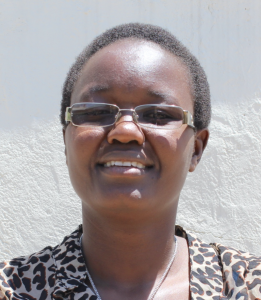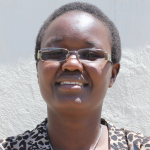July, 2020: COVID-19 Prevention Training Update at Sasala Community, Kasit Spring
Our teams are working on the frontlines of the COVID-19 pandemic. Join us in our fight against the virus while maintaining access to clean, reliable water.

Distributing COVID-19 informational pamphlets
We are carrying out awareness and prevention trainings on the virus in every community we serve. Very often, our teams are the first (and only) to bring news and information of the virus to rural communities like Sasala, Kenya.

Filling the handwashing station with clean water for use
We trained more than 30 people on the symptoms, transmission routes, and prevention of COVID-19. Due to public gathering concerns, we worked with trusted community leaders to gather a select group of community members who would then relay the information learned to the rest of their family and friends.

Handwashing demonstration
We covered essential hygiene lessons:
- Demonstrations on how to build a simple handwashing station
- Proper handwashing technique
- The importance of using soap and clean water for handwashing
- Cleaning and disinfecting commonly touched surfaces including at the water point.

Practicing the handwashing steps
We covered COVID-19-specific guidance in line with national and international standards:
- Information on the symptoms and transmission routes of COVID-19
- What social distancing is and how to practice it
- How to cough into an elbow
- Alternative ways to greet people without handshakes, fist bumps, etc.
- How to make and properly wear a facemask.

Handwashing
During training, we installed a new handwashing station with soap near the community’s water point, along with a sign with reminders of what we covered.

Social distancing check
Due to the rampant spread of misinformation about COVID-19, we also dedicated time to a question and answer session to help debunk rumors about the disease and provide extra information where needed.

Mask sewing session
"We have heard a lot of contradicting information about Coronavirus that left us confused, so we are grateful for this training we have received today," said spring landowner Mr. Kasit in his closing remarks at the training
"We are now enlightened and we got the privilege to ask questions and share our concerns. Thank you to your trainers for responding to our many questions and concerns and you gave us responses that were satisfactory,’ he added.

The completed sample mask
We continue to stay in touch with this community as the pandemic progresses. We want to ensure their water point remains functional and their community stays informed about the virus.

The training group poses with their pamphlets at the end of the day
Water access, sanitation, and hygiene are at the crux of disease prevention. You can directly support our work on the frontlines of COVID-19 prevention in all of the communities we serve while maintaining their access to safe, clean, and reliable water.

October, 2019: Sasala Community, Kasit Spring Project Complete!
Sasala Community now has access to clean water! Kasit Spring has been transformed into a flowing source of water thanks to your donation. We protected the spring, provided 5 sanitation platforms to different households in the community, and we trained the community on improved sanitation and hygiene practices.

Protecting Kasit Spring is of great impact to the Sasala community members in all spheres of life. Through this project, community members have seen how the spirit of teamwork can be harnessed to achieve a desired common goal. People in this community will be able to save money to some extent that at times would otherwise be diverted to treat unnecessary waterborne diseases.

This project will generally promote a healthier society and members of this community are so grateful for the project. They expressed their hope that our organization would continue to expand assistance to more communities so that they too can access safe and clean drinking water.
Spring Protection
Community members provided all locally available construction materials, including bricks, wheelbarrows of clean sand, stones, and fencing poles. Accommodations and meals were provided for the artisan, too.
The Process
Women and men lent their strength to the artisan to help him with manual labor. The spring area was excavated to create space for setting the foundation of thick plastic tarp, wire mesh, and concrete. After the base had been set, both wing walls and the headwall were set in place using brickwork. The discharge pipe was fixed low in place through the headwall to direct the water from the reservoir to the drawing area.

Community members assist artisan with brickwork
As the wing walls and headwall were curing, the stairs were set and ceramic tiles were fixed directly below the discharge pipe. This protects the concrete from the erosive force of the falling water and beautifies the spring. The process of plastering the headwall and wing walls on both sides reinforces the brickwork and prevents water from the reservoir from seeping through the walls and allows pressure to build in the collection box to push water up through the discharge pipe.

Cementing and plastering continue
The source area was filled up with clean stones and sand and covered with a thick plastic tarp to prevent potential sources of contamination. It took about 2 weeks of patience for the concrete to dry. There were no challenges to the construction process, as it was a good community to work with. They cooperated so well and this contributed to the success of the project without delays since the 2 parties worked hand in hand.

Community members celebrate the newly completed spring
As soon as it was ready, people got the okay from our field officers to begin fetching clean water. We met them there to celebrate this momentous occasion.

"I want to take this opportunity to appreciate [your team] for this project," said Tekla Mmasi, a 23-year-old student in her village.
"We have been drinking water that is neither safe nor clean for decades and at times we got waterborne diseases that cost us lots of cash to treat. We are now glad that the water is safe and clean for human consumption and contracting unnecessary diseases will be a thing of the past.''

Sanitation Platforms
All 5 sanitation platforms have been installed.

Proud new sanitation platform owner
These 5 families are happy about this milestone of having a private latrine of their own and are optimistic that people will no longer leave waste outdoors. We are continuing to encourage families to finish building walls and roofs over their new latrine floors.

New Knowledge
Mr. Peter Kasiti, a farmer and local leader within his community, was tasked with organizing the training. He gave us the community’s preferred date for training, for he was very much aware of the community calendar when it comes to planting season and other big events.
Some 20 people attended training, which was more than we expected. This was because, at the time of the participants' arrival, the rain started to fall immediately and we thought the community members would not turn up for the training. But, we were happy to be wrong and welcomed the participants. Training started inside in a local church in preparation for the rain, but we ended up moving our chairs outside for better air and light once the skies cleared.
The attendees were so active during the session, even including the children. A majority could ask questions to get more clarification on different topics that were handled by different facilitators. This was so interesting and it was a clear indication that they were all eager to learn.
We covered several topics including leadership and governance; operation and maintenance of the spring; healthcare; family planning; immunizations; and the prevention and spread of disease. We also covered water treatment methods, personal care like handwashing, environmental hygiene, hygiene promotion, and many other things.

Training participants look on with smiles during a handwashing demonstration from their neighbor
The operation and maintenance of the spring was a topic that got the attention of many community members since it was so interactive since the facilitator asked questions that could prompt them to respond. They suggested ways that would enable them to care for the spring.
One activity that took place during this session was planting grass to avoid soil er0sion. Another one was fencing that the community members supported after the training. This was so nice to see a spirit of teamwork among them. Planting of grass and fencing at times become challenging on some sites but for this one, it became so easy to do it through their excellent teamwork.

On-site training
When hygiene and health promotion was handled, the facilitator explained what every person should do to lead a healthy life. She demonstrated the new way to brush their teeth and a volunteer was asked to demonstrate how they normally do it. Interestingly, a young girl about 10 years of age came up and did it. The attendees were also asked to demonstrate how they wash their hands and thereafter they were shown the new method to wash hands. This made the session so lively.

Say "Ah!" Dental hygiene training and toothbrushing demonstration
"The new water point is so nice and we are assured of our health as a community. Thank you so much, you have been a blessing to us," said Mr. Kasiti.

Thank you for making all of this possible!


 Protected Spring
Protected Spring
 Rehabilitation Project
Rehabilitation Project
















































